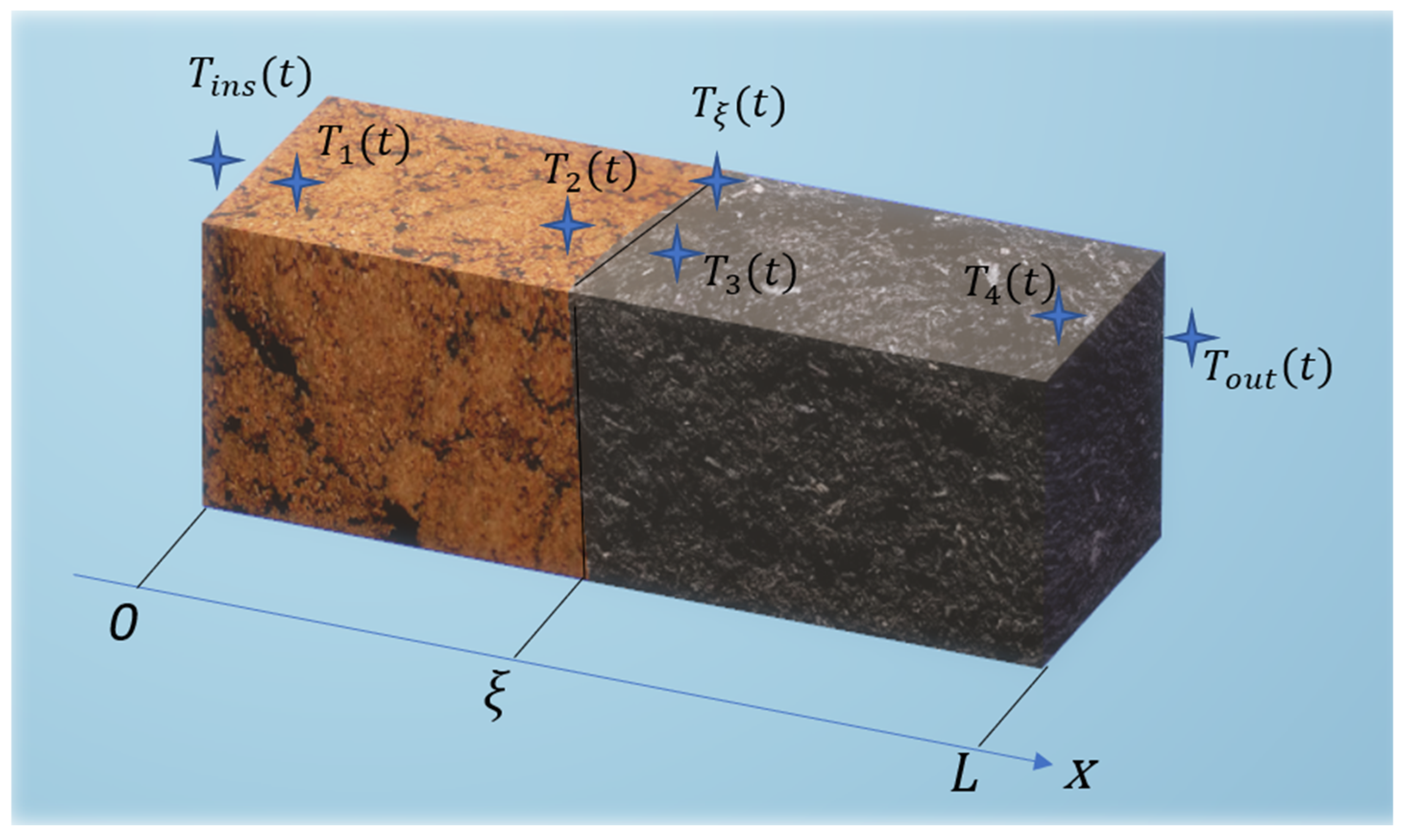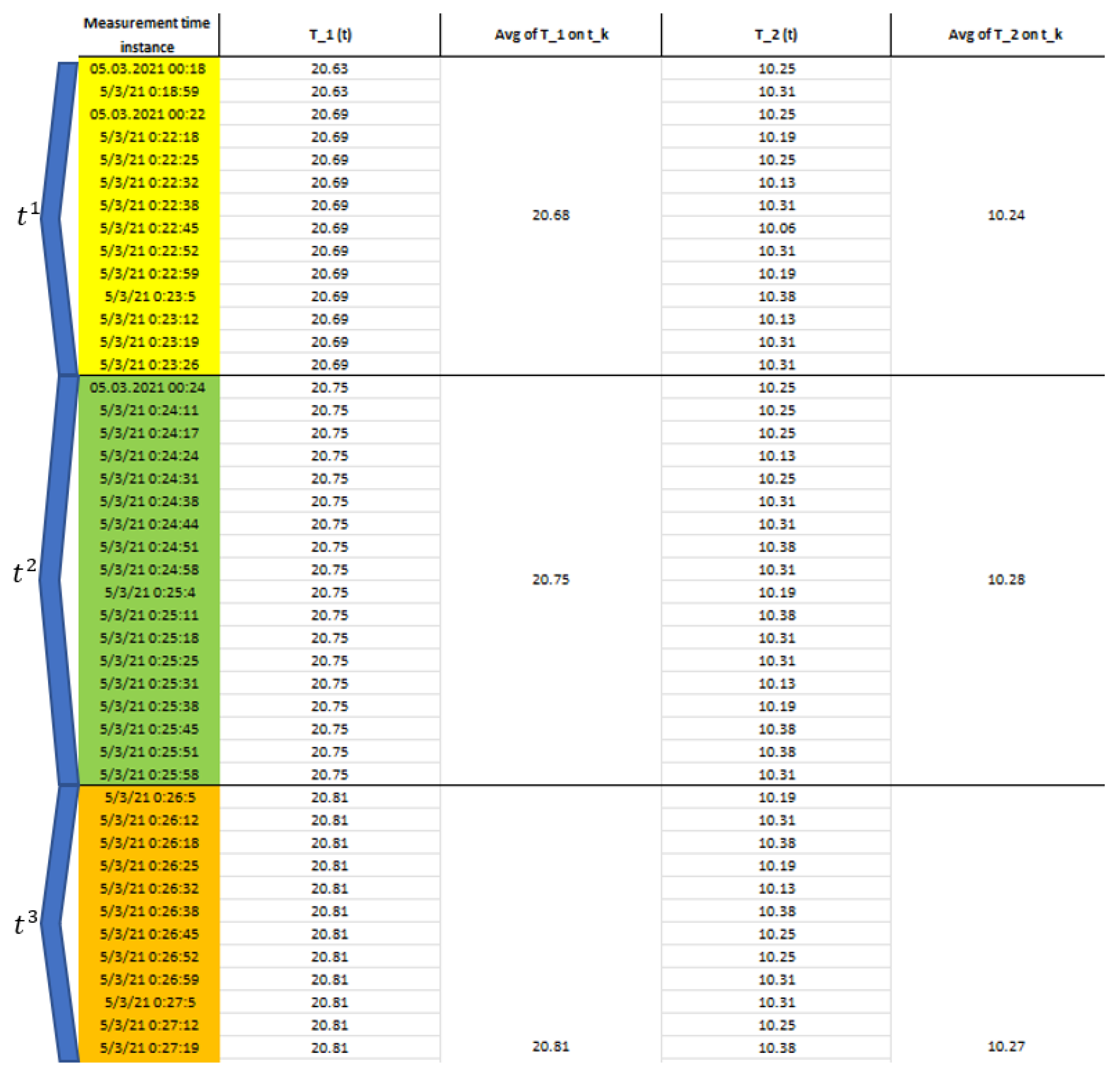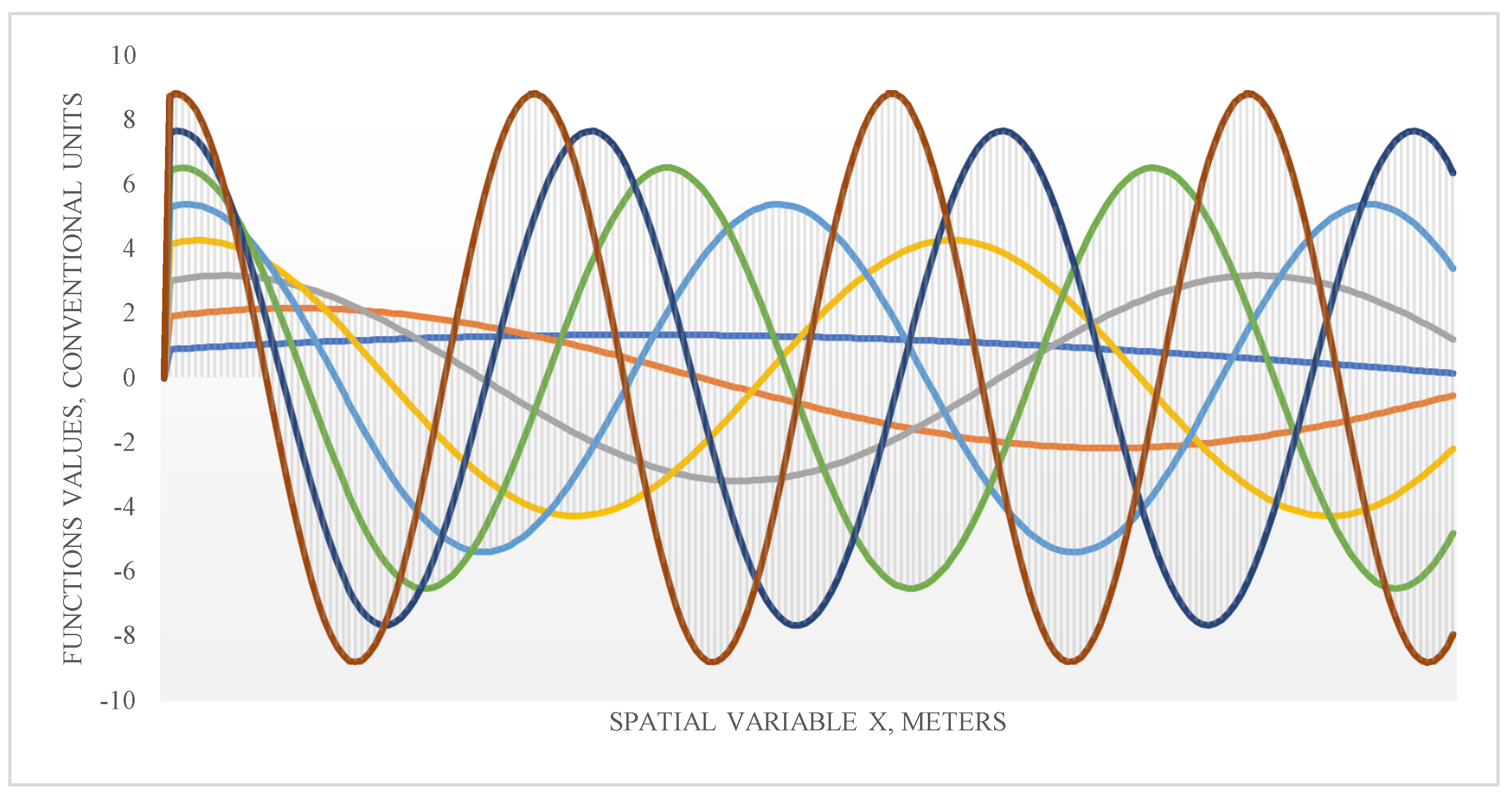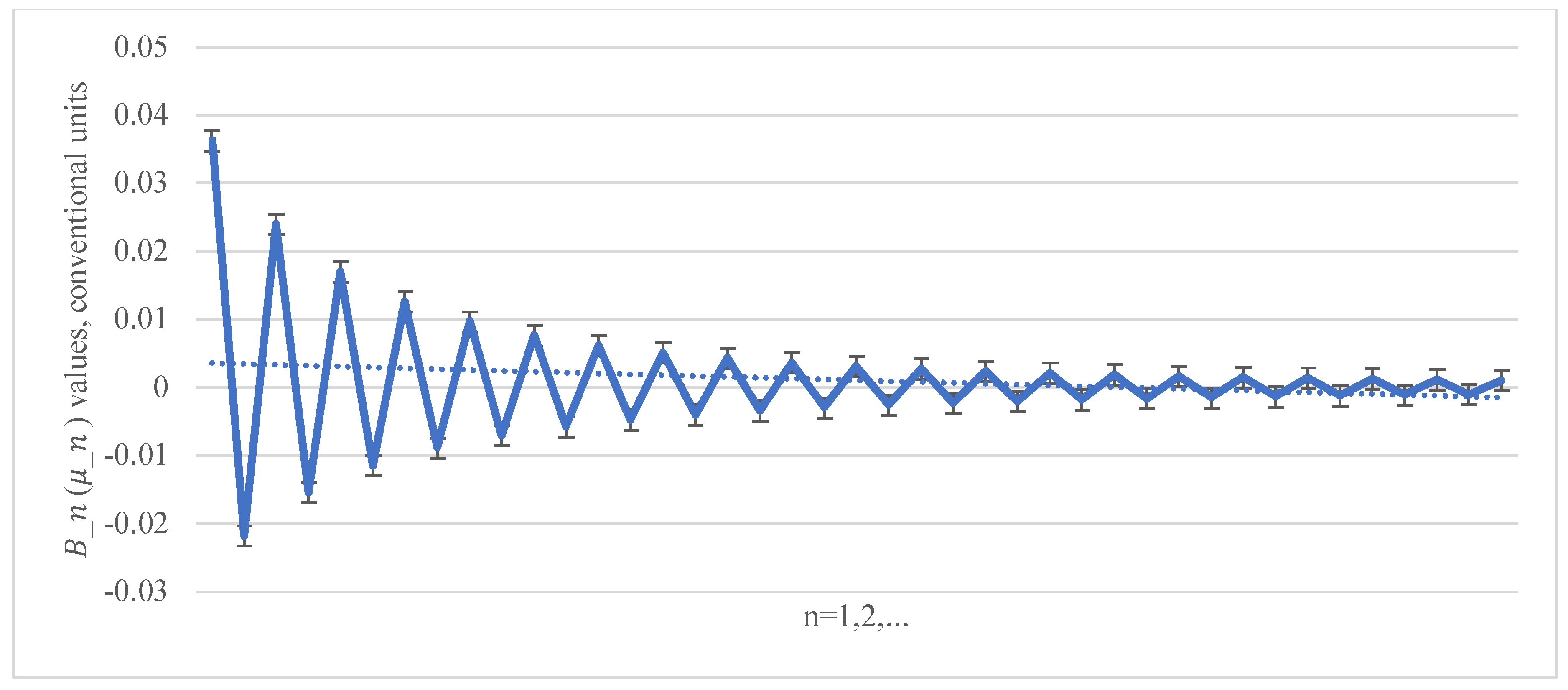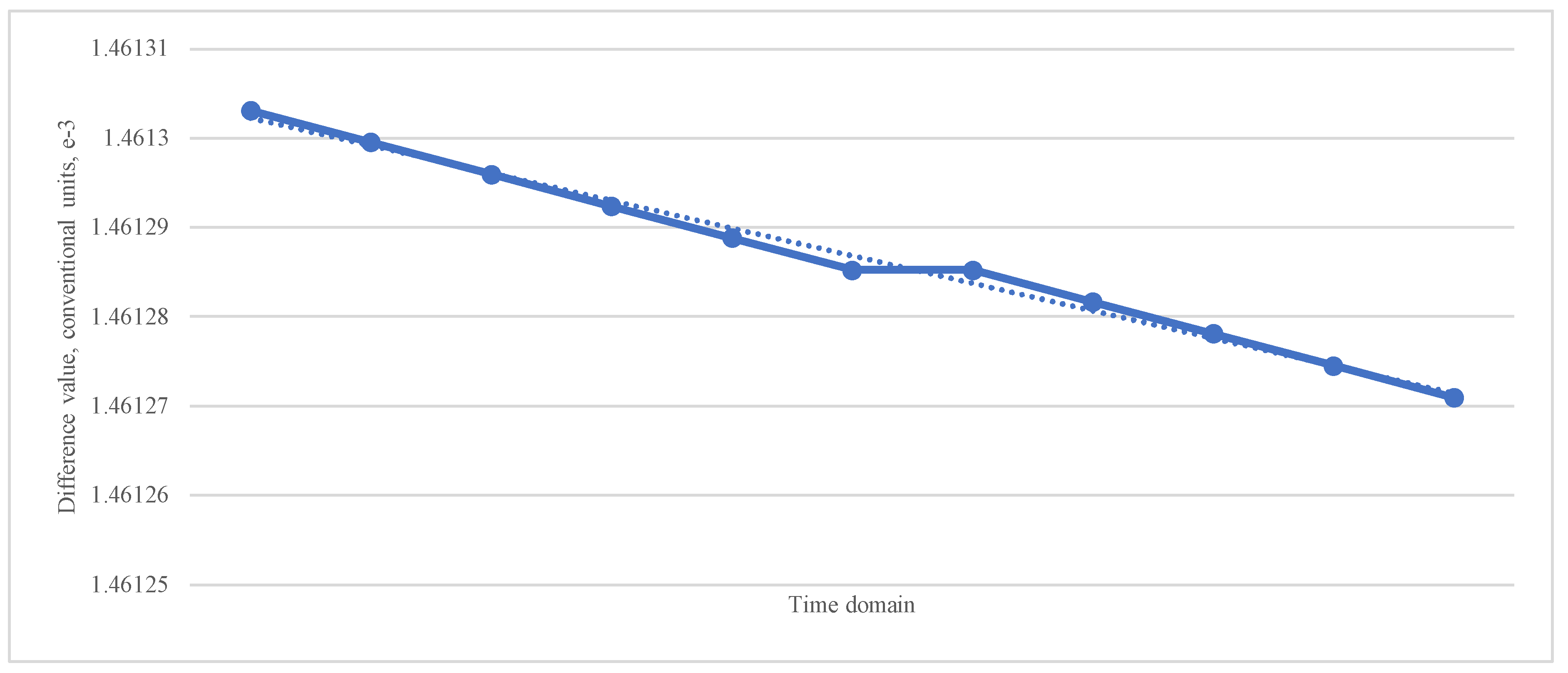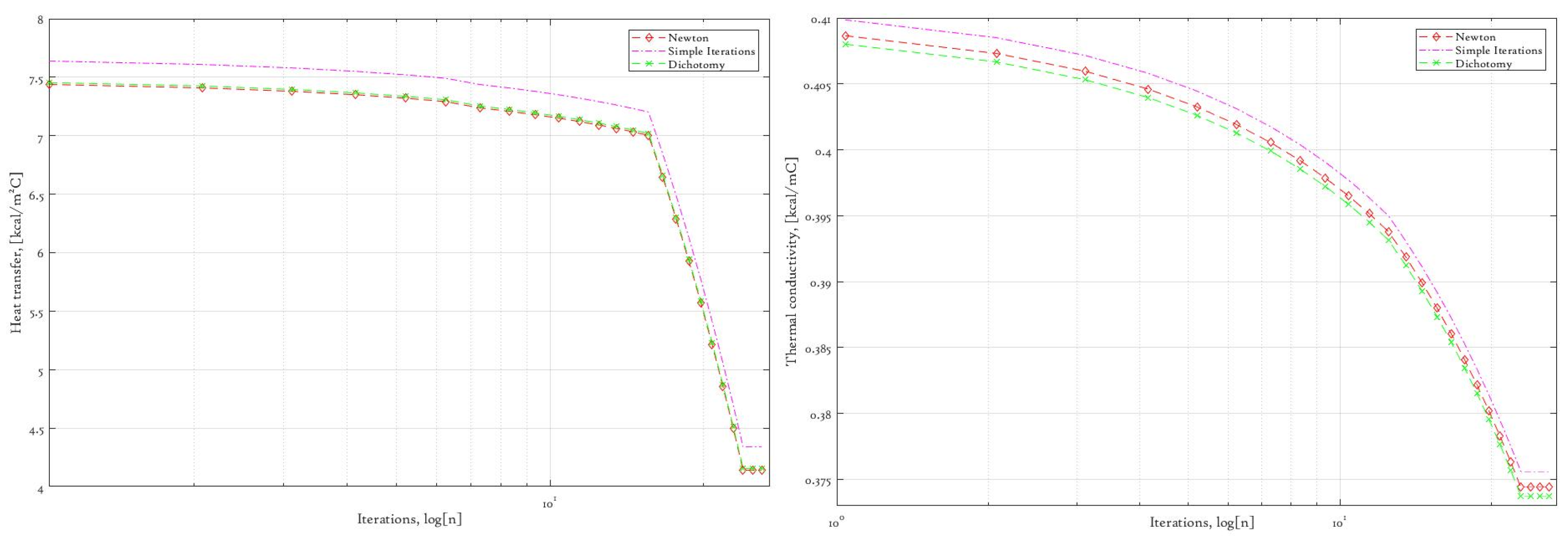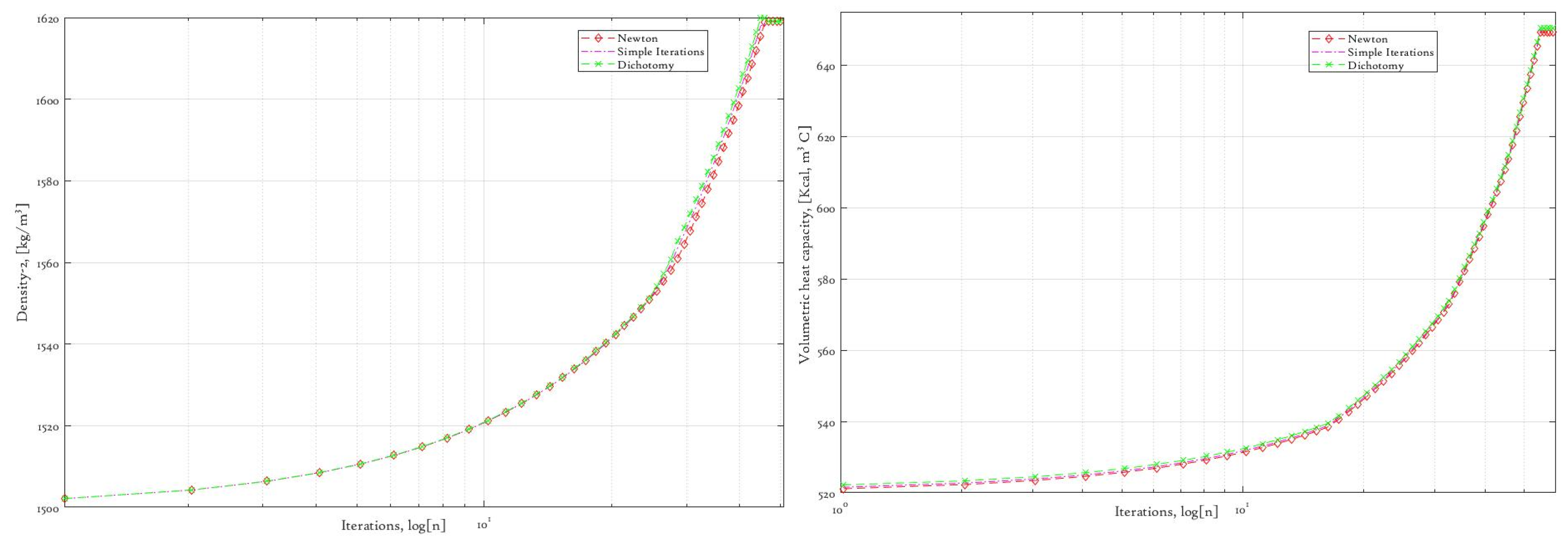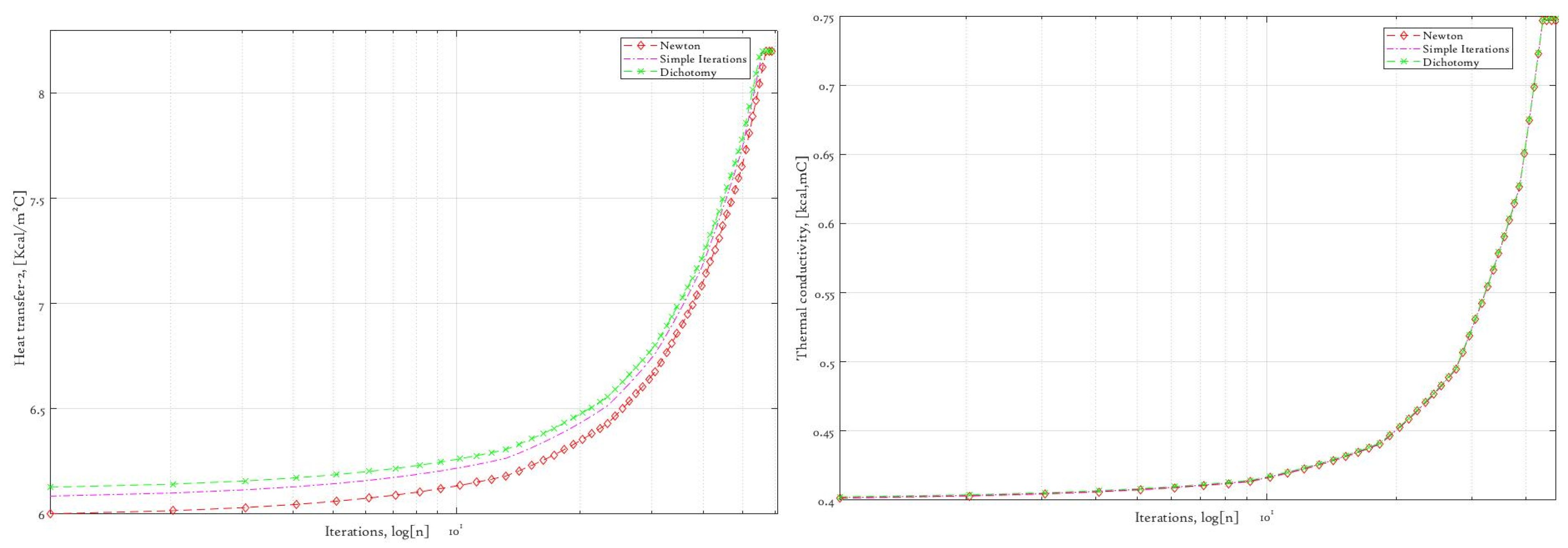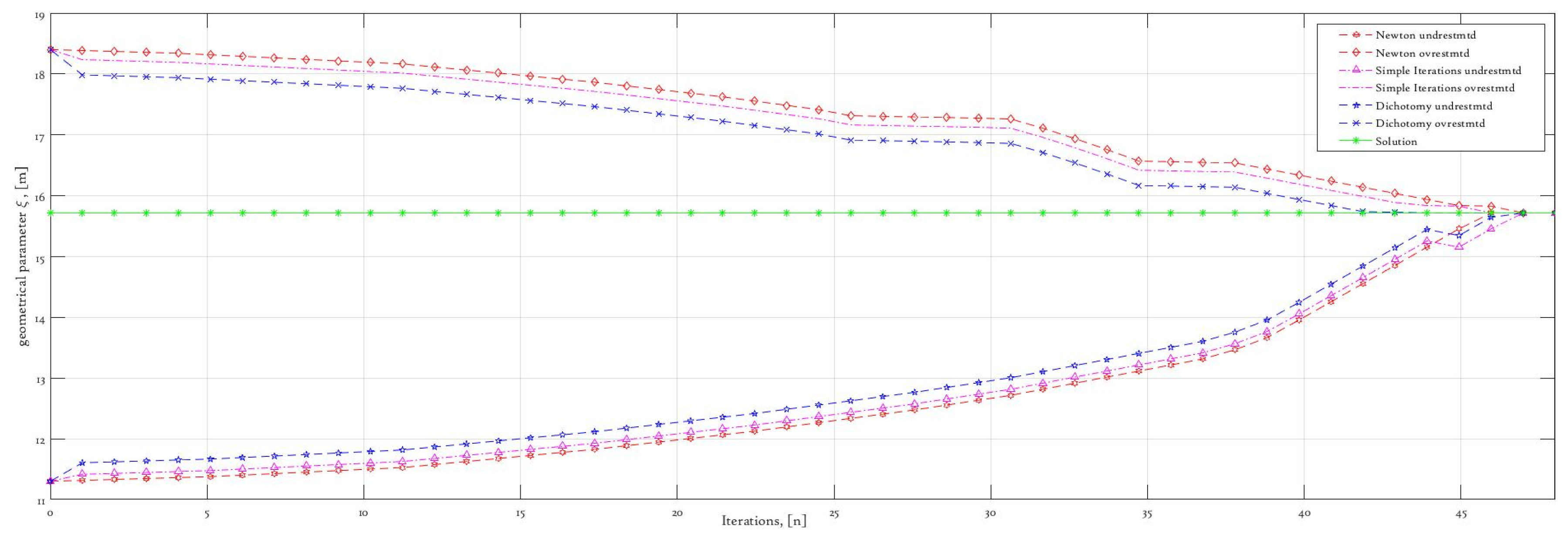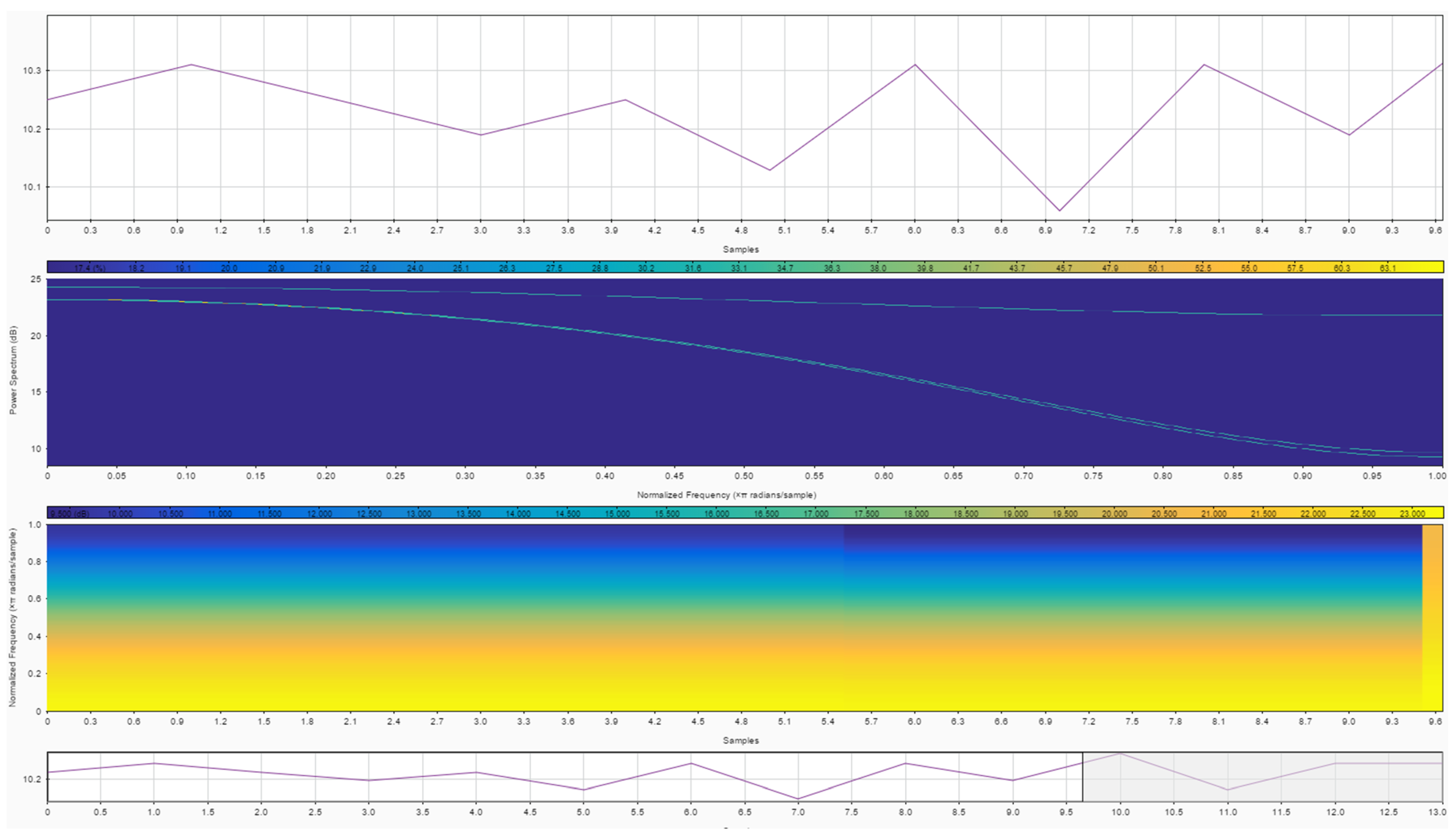1. Introduction
The theory of inverse problems is undergoing the tendency of reach development and starting to play an essential part in various areas, with special emphasis on medicine, material science and structural engineering, where it is applied in different forms [
1,
2,
3,
4]. In most engineering practices, the necessity of precise values of key physical parameters of governing equations for variables of interest is difficult to overestimate. The process of obtaining such initial data practically requires the conduction of experimental estimation in laboratory conditions that in turn leads to increases in cost and time of production. Most novel approaches require key parameters to be subjected to topological optimization-based algorithm seeking for error estimation of objective functions and solving of the posed problems [
5]. Another novel method uses impulse response analysis, which requires derivations of transfer mappings based on Green’s functions, widely used for the heat conduction problem solving technique, and it allows the determination of the heat flux via deconvolution and spectral density estimation through the inverse fast Fourier procedure [
6]. However, the recent tendency in common practice demonstrates the need for a simplified methodology which could be free of mesh generation, numerical integration and regularization, allowing the addressing of heat source problems for functionally graded materials through homogenization functions [
7]. At the same time, problems when retrieval of the boundary conditions is required for ill-conditioned inverse problems used for remote sensing reveal a need for an increased number of observations for data assimilation to overcome numerical instability [
8]. Such problems are typical for the determination of initial characteristics of a considered domain, such as the determination of the shape of a rotating body by temperature measurements. In this case, the optimal control method may be implemented to overcome the ill-posing, as such problems are basically nonlinear [
9]. Another technique utilized for the determination of the temperature and the heat flux distributions requires optimizing relationships between the intensity and duration of heat on the boundary of the workpiece. In such methods, special attention is required to ensure conditions of uniformity and stability by investigating the influence of the measurement noise [
10]. There are some metaheuristic approaches applied for solutions of inverse heat transfer problems involving the phase change of materials during solidification or melting processes. Such approaches give an opportunity to investigate the relationship between the effective heat capacity and temperature, accounting for phase-change hysteresis. The phase change enthalpy in this case could be obtained by the solution of the inverse problem [
11]. The spatial and temporally varying convective heat transfer coefficient determination via inverse problems approach requires derivation of the adjoint method-based conjugate gradients along with sensitivity differential equations [
12]. In our problem statement, we pose a transient heat transfer problem with open boundaries, and thus we face most of the abovementioned issues. However, we are looking for simplified algorithm development designed through the homogenization of the boundary conditions and decomposition of the time domain into quasi-stationary sub-intervals. This approach allows us to overcome the derivation of the transfer functions and adjoint conjugate gradients, keeping the accuracy at an efficient level due to the analytic behaviour of the suggested designed algorithm. Furthermore, we present a derivation technique of the analytic solution of the direct problem, homogenization steps for sampled experimental measurements and an iterative algorithm for the determination of all thermo-physical parameters for a two-layered domain via the solution of a heat transfer inverse coefficients problem along with posed and proved theorems, which allows us to determine the spatial component of the contact conditions. For that reason, we set our main goal to derive analytical expressions that will make it possible to determine eight key physical parameters at the same time along with the geometrical characteristic. This goal is achieved with the help of the process of homogenization of the sampled measurements through the presented relations, posing and proving the main lemmas, constructing the computational algorithm and validating the derived expressions via the comparison of the computed values with the empirically received measurements. We also discuss issues of the stabilization, convergency rate and analogous biharmonic inverse problem by citing appropriate references.
For the problem formulation, we use the introduced domain:
; however we split a two-layered problem into two one-layer models that we will solve separately and unite via the contact condition:
To neglect nonlinearity effects, we assume major coefficients to be as established in the following piece-wise functions:
Here we introduce the expressions
and
. In order to obtain the analytic solution for Problems (1)–(5), we apply the Fourier method, i.e., we seek for solution in the form:
The Fourier method that we are intending to use to solve the posed problem is not applicable directly to the boundary conditions in Forms (2) and (3) due to their non-homogeneous nature. Thus, we firstly consider the time sub-domain in which the fluctuations of temperature on the outlets are negligible, and we may assume the ambient temperature fields to be constant, i.e.,
. In order to obtain homogeneous boundary conditions for the governing Equation (1), we introduce another continuously differentiable function
which is linked to the initial function
via the following relation:
where
and
some constant coefficients that we will choose in such a way that will give us homogeneous boundary conditions for the newly introduced function
. Because
, it follows that our Conditions (2) and (3) will take following form:
Thus, the homogenization of the boundary conditions for
consists in satisfying the following identities:
The major determinant of System (11) is:
The auxiliary determinants of System (11) are:
Thus, we may determine unknown coefficients as:
This gives us the following identity to link the two functions with each other:
where
. From another point of view, we have an equivalent relation,
considering the following differential relations:
We may conclude that the governing equation for the function
is the same as the initial governing Equation (1), i.e.:
Now Equation (17) is solvable with the following boundary conditions:
We seek the solution of Problems (17) and (18) in the form
; after some transformations we obtain the following system of equations:
The first equation of this system has following solution [
13,
14,
15]:
We investigate the form of the solution for the second equation of System (19) in the form of the following trigonometrical function [
16,
17,
18,
19,
20]:
Thus, we obtain an exact form of the function
:
Using the boundary condition
, we obtain:
Because we are looking for non-trivial solutions of the governing Equation (10), we assume that:
Furthermore, we obtain an equation to be solved:
Applying the first boundary condition of (18), we obtain:
Also, we shall note that
; thus, it follows that the Robin condition will take the form:
Assuming the inequality
, we obtain the following formula:
By transforming Equation (25), we obtain the following relation between coefficients
and
in the form of the equation:
Considering together Equations (28) and (29), we obtain the following transcendental equation:
The transcendental equation above should be solved numerically for parameter
, and we obtain values for
. After that, Solution (22) could be rewritten as:
Using Expression (26), we may present the solution via an unknown coefficient as:
We will denote
again by
, for convenience, and then
Equation (10) is linear, and therefore we present the solution now in the form of the following series:
Here, is an eigenfunction of Equation (17) on the subdomain . We present the following Lemma:
Lemma 1. if, we have the following identity: Proof. The eigenfunctions represent the solution of Equation (10), and thus we have following identities:
To sustain the proof further, we multiply the first equation by
and the second by
and subtract the second expression from the first, obtaining:
Also, we imply the following identity:
That procedure gives us the next formulation:
We integrate the last expression by spatial component
from
to
and receive:
Also, we may obtain the boundary conditions for the functions
and
:
Applying these boundary conditions to our integral relation (40), its left side will turn to 0, and we may obtain following expression:
When we take
we derive the orthogonality of the functions
and
:
□
Now we pose the following Lemma 2.
Lemma 2. The computational formula for the norm of the eigenfunctiontakes the following form: Proof. We will directly start by computing the following definite integral:
Firstly, we will apply the formula of decreasing order:
Next, after computing the integral directly, it will lead us to the following identity:
After plugging the limits into this expression, it will be transformed into:
Also, we are implying the following trigonometrical identities:
From another side, due to (6) we may obtain the equality
, and thus our norm will be rewritten as:
The lemma is thus proved. Going back to Formula (34) and considering the case when
, we receive:
where
. Furthermore, we multiply both sides of (21) by the function
and integrate it by spatial variable
from
to
. Considering Lemmas 1 and 2, we may conclude that:
□
Now, from the last expression, we may identify the coefficients
by the formula:
After we have demonstrated the derivation of the first sub-domain solution, we will perform the same algorithm over the second part of our spatial domain. We will perform homogenization for the following initial-boundary value problem and derive an equivalent problem for the function
:
Again, we apply the following substitution to link two functions between each other:
In this case the boundary conditions for System (54) will take the form:
In order to obtain the homogeneous conditions from the last system, we shall note that:
Now, we may determine the coefficients
and
using Cramer’s method, utilized for our coefficient’s matrix. In some cases, the same approach may be also utilized for the quaternion matrix equations [
21,
22,
23]. Firstly, we evaluate the main system determinant, assuring it will provide us one unique solution:
After that, we investigate the auxiliary determinants:
Thus, we obtain computational formulas for the homogenized coefficients:
As a consequence, we construct the adjoint problem for the function
with homogeneous boundary conditions:
Furthermore, for convenience we introduce another spatial variable
, and then we may substitute
. Also, the following expressions may hold:
We will further use the variable
denoted through the same variable
, and our System (25) will take the form:
In analogue with the first sub-domain problem, we seek the solution of the second posed Problem (63a) via the Fourier method in the following form:
. We derive the system of ordinary differential equations:
The solution of the given system will have the form:
The boundary conditions for System (63) for the eigenfunction
will take the form:
We consider these boundary conditions along with the following identity:
Now we may rewrite the system as:
Because we are interested in non-trivial solutions of the last system, we note that
. Thus, it follows that:
This has an equivalent equation:
Solving the transcendental equation written above numerically, we may obtain the set of eigenvalues
. These values will give us now another set of eigenfunctions:
It follows now that the solution of Problem (63a) will take the form:
Now, we pose Lemma 3.
Lemma 3. The system of eigenfunctions will be orthogonal on.
Proof. From the definition of the functions
and
, it follows that they should satisfy the equations:
We multiply the first equation by
and the second by
and subtract the second from the first, which gives us:
Alternatively, this is equivalent to the expression:
After that, we integrate along the spatial variable
from 0 to
:
At the same time, our eigenfunctions
and
should satisfy the following boundary conditions from the system of Equation (54):
Thus, from the last integral relation, we obtain an expression in the form:
Because , it follows that . □
Now, we may compute this integral:
We implement the formula of order reduction and compute another equivalent integral:
Using Equation (69), we obtain the final form for the norm
as:
Now, in order to determine the coefficients
, we take Identity (71) and consider the case when
At the same time, we recall that
; thus, we may conclude that:
This gives us the computational formula for the determination of coefficients
as:
Because we initially introduced the spatial substitution
, from which we obtained
, transforming back the spatial variable will give us:
Right after we have obtained the solution of the initial problem statement for the direct problem, we may identify the temperature field by the following Algorithm 1:
Step 1. We compute the homogenization coefficients by the set of formulas:
Step 2. We solve numerically the following transcendental equations and obtain two sets of eigenvalues,
and
:
Step 3. We compute the norm of the eigenfunctions of the first and second problem via the formulas:
Step 4. After that, we evaluate the following coefficients by:
Step 5. Now we are ready to determine the solutions for initial-boundary value Problems (1)–(5) by the following formulas:
After the solution to the direct problem is received, we may pose the inverse problem and demonstrate its solution algorithm. The formulation of our inverse problem is that in using the measured temperature values at seven points, as indicated in
Figure 1 below, it is necessary to determine the values of eight thermo-physical parameters and one geometrical characteristic of the two-layered medium terrain. We write two sets of parameters, noting that the geometrical constant
will be evaluated by both sub-domain problems simultaneously due to contact Condition (5):
Firstly, to determine the coefficients we shall specify a time partition, where ambient temperature is constant, i.e., with fluctuations that may be neglected in order to obtain homogeneous boundary conditions, as illustrated on
Figure 2 below.
Afterwards, on each such time sub-domain
we evaluate iteratively by one parameter from our
and
. To solve the system of nonlinear equations that we receive upon the determination of unknown parameters, we employ numerical iterative algorithms, such as the Newton’s method, dichotomy or the simple iterations method [
24,
25,
26,
27]. We estimate each parameter iteratively and perform Algorithm 1 to compute the temperature field on each iteration until we reach the following stop criterion:
where
is predefined accuracy,
is the measurement device position, and
is the measured temperature. By using the measurements at the first indicated point, we construct the following functions to be minimized; it could be investigated whether the proposed functions perceive the local convex properties. However, in a case of a non-convex function, we may utilize the least square method to solve an equivalent convex extreme problem:
After we evaluate these four parameters of the first set
, we additionally clarify these values via the same optimization problem from the system with measurements received from the second device, with
being the position of the second measuring device:
In the same step, we go to the next device measurements and perform the same procedure for another four parameters of our system
:
We also perform the same clarification via the last, fourth measurement device, constructing the following system:
At each iteration we observe the changes of all system parameters, performing evaluation via Algorithm 1 through Formulas (86)–(90). However, to determine the geometrical parameter, we implement the contact condition, obtaining another convex function subjected to minimization:
The computational algorithm consists of suitably selected procedures for the temperature measurements, avoiding high levels of fluctuation of more than 0.1% in degrees. Afterwards, we solve Systems (93)–(97) via three different numerical methods: Newton’s, dichotomy and simple iterations, checking at each iteration the criterion (92) that indicates the level of correspondence of the seeking parameters. We present below the separate changes along each iteration of the computed coefficients. Also,
Figure 3 below indicates the eigenfunctions on the root of the transcendental equation perceiving the orthonormal behaviour:
The uniform equicontinuity of the Fourier coefficients (89) indicates uniform convergency of the posed norm (88) by the Arzelà–Ascoli theorem [
28,
29,
30], which can be verified via the Cauchy sequence behaviour [
31,
32,
33] observed in the plot below in
Figure 4:
At the same time, we observe the decrease of temperatures’ differences, indicating monotonous convergency in the posed criterion (92) in the plot below in
Figure 5.
The set of values over iterations demonstrate gradual estimation, and we may observe that the initial approximation was overestimated.
As can be observed from
Figure 6, the initial approximations that we chose were overestimated; thus, through the iterations we obtain a gradual decrease in values until we reach stationary values at several final iterations. Although we see small differences in the convergency rate that depend entirely on the numerical method that we choose, it is a matter of fact that the final results are still the same.
As we also observe in
Figure 7, from the determination of another two parameters, there is the same gradual decrease over each iteration, with various convergency rates and slight differences in the final result. This occurs due to the low orders of the parameters’ values; it may be regularized by the introduction of higher-order accuracy in stop criterion (92), which will lead increase in the number of iterations. For the computation of the first layer’s four parameters, we use first two systems of Equations (93) and (94), while another two systems of nonlinear Equations (95) and (96) are used for the second part of our parameter set. However, we intentionally present underestimated initial approximations for the second medium layer, observing the following profiles in
Figure 8:
Although the differences in the convergency rate vary over iterations in the second case less in comparison to the first layer parameter estimation procedure, we may connect this observation with the solid decrease in the uncertainty level due to the underestimated initial approximations that we obtain by bounding the above goal function parameters. Still, the matter of the convergency rate may be easily improved by selecting the corresponding iterative approach if certain stability condition constraints are applicable for the posed model [
34,
35,
36,
37,
38]. Now we demonstrate estimation of the geometrical parameter via iterative Solution (97). We apply the same iterative methods while choosing different initial approximations, selecting them to be both underestimated and overestimated in order to validate the received expressions depicted below in
Figure 9:
As can be clearly observed from
Figure 9, there is a stable approach for the exact value from both ways, which is achieved via meaningful selection of some physical constraints. Thus, in the case of selecting such constraints sequentially, parameter tunning is not necessary [
39]. However, as was reflected by various investigations [
40,
41,
42], the parameter value used for regularized inverse problems is quite critical, as it affects the results and the optimal order of convergency.
We also investigate the noise simulation as a divergence-free vector field, as the measurements taken with devices include some error during the input process. For that reason, we observe the noise error as:
Here,
is the prescribed error of the measuring device taken at a selected point, which could be taken as a smooth-step sigmoid-like interpolation and clamping function, as depicted below in
Figure 10.
At the same time, we may extend the prescribed error to an analogue of simplex noise scaling to a higher dimension, reducing the computational cost to instead of
